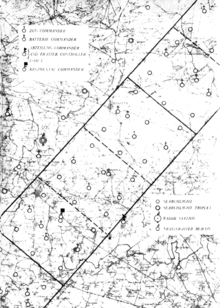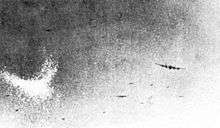Bomber stream
The bomber stream was a tactic developed by the Royal Air Force (RAF) Bomber Command to overwhelm the night time German aerial defences of the Kammhuber Line during World War II.
The Kammhuber Line consisted of three layers of zones of about 32 km long (north–south) and 20 km wide (east–west). In each zone there were two German night fighter aircraft receiving ground-directed guidance from their own Himmelbett controller within each zone. While the Himmelbett control center could only handle two fighters, this was adequate for dealing with the RAF Bomber Command tactic of sending its night time bombers individually, with each bomber plotting its own route to the target, to avoid flak concentrations.

At the urging of British scientific military strategist R. V. Jones, Bomber Command reorganized their attacks into streams carefully positioned to fly right down the middle of a cell.[1] The introduction of the GEE navigation system allowed the RAF bombers to fly a long, tight, formation in the dark—a 'stream of bombers' flying a common route at the same speed to and from the target, each aircraft being allotted a height band and a time slot in a bomber stream to minimize the risk of formation collision.
In one of the first applications of statistical operational research, the RAF estimated the number of bombers likely to be lost to enemy night fighters and flak, and how many would be lost through collisions. Minimizing the former demanded a densely packed stream, as the controllers of a night fighter flying a defensive 'box' could only direct a maximum of six potential interceptions per hour, and the flak gunners could not concentrate on all the available targets at once.
A typical bomber stream of 600 to 700 aircraft was on average 8 or 10 miles broad, and 4,000 to 6,000 feet deep.[2]
The bomber stream allowed a bombing raid to be completed in a shorter time frame, further overwhelming the defensive tactics of the German forces. The earlier RAF tactic of sending bombers on individual routes meant that it could take four hours before all its planes would have passed over their target; the bomber stream reduced this window to 90 minutes.[3]
The first use of the bomber stream was the first 1,000 bomber raid against Cologne on the night of 30–31 May 1942.[3]
The tactic proved successful and was used until the last days of the war, when centrally-organised German air defences had ceased to exist.
See also
References
- ↑ Blum, David M, A Game-Theoretic Analysis of Electronic Warfare Tactics with application to the World War II Era (PDF), MIT, pp. 20–34.
- ↑ "The World at War" Episode 12 - Whirlwind - 1973
- 1 2 The Thousand Bomber raids, 30/31 May (Cologne) to 17 August 1942, UK: RAF, archived from the original on 6 July 2007 External link in
|publisher=(help)
Further reading
- Dyson, Freeman (1 November 2006), "Part I: A Failure of Intelligence", Technology Review, retrieved November 2013 Check date values in:
|access-date=(help) — article by one of the men who was in RAF Bomber Command's Operational Research Section and did some of the research that preceded the introduction of the bomber stream.
